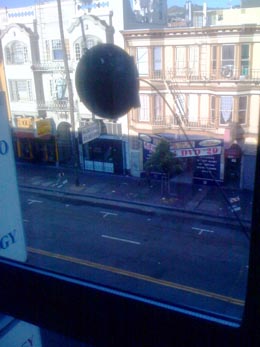Ambiences with Boundary Mics
Posted: April 18th, 2010 | Author: Nathan | Filed under: field recording, gear, theory
UFO or listening device?
I learned a long time ago to share my mistakes with others. It keeps me humble, and reaches two groups of people: Those more experienced than me who can help correct my errors, and those who might not have tread these waters before and who can learn from my experiences.
Which brings us to today’s post: recording ambiences using a pair of miniature omnidirectional microphones in boundary layer mounts. I learned a ton doing this, but the end results weren’t great. Today we’ll talk about what I accomplished and why it might not have worked out as well as I had hoped.
After my recent post on urban ambiences, I decided to record some fresh ambiences using a pair of DPA 4060 microphones using two techniques I hadn’t tried before: spaced-pair stereo and boundary-layer microphones.
Spaced-pair stereo is a technique that’s based on both relative volume and delay of sound reaching two omni-directional microphones several feet apart. This gives the sense of a stereo field. I was recording street-level ambiences from a third story of a building, and settled on about a 12′ distance between the microphones. (There are equilateral-triangle and 3:1 guidelines about intra-mic-and-subject spacing, but I did as best as the local architecture allowed!)
After recording for a while, I mounted the DPA 4060’s into boundary layer mounts (BLM’s) and kept them the same distance apart. Boundary microphones work by taking advantage of the boundary effect, wherein sound undergoes natural amplification just a fraction of an inch above a large, solid surface. While certainly not as good as a dedicated boundary mic like a Sanken CUB-01, it’s a nice way to start experimenting. So, I popped the 4060’s into the mounts, taped the mounts to my office windows, and got rolling.
Today’s sound is simply comparing two sets of vehicle pass-by’s, taken from a much longer city-ambience recording. The first is with the standard DPA 4060’s in their foam windscreens and Remote Audio MicroCats to eliminate wind noise. The second features the same mics in the same positions, but popped into the boundary layer mounts. For my part, I noticed two major things.
- First, the apparent (limited) stereo field is mostly from volume differences between the mics and not the distance between them. Based on where the sound originated from, the delay in transients between the two mics was less than 30ms. Greater separation would have helped, I suspect: The separation I used is probably good for chamber orchestras but not for a whole city block.
- Second, the BLM’s produced a much tighter sound; I sense more sounds of cars on the road than the roar of cars reflected off of the nearby buildings. I think that the windscreens on the DPA’s attenuated more high-frequencies than the BLM mounts did , but still – the difference in crispness is pretty intense. Listen to the birds in each clip, especially. However, the center of the stereo image is pretty “dead.”
I’d love to hear if others have used similar techniques, or have better best practices around them, in the comments of this post!
[soundcloud url=”http://soundcloud.com/noisejockey/vehicle-by-ambience-spaced-pair-lavs” params=”show_comments=true&auto_play=false&color=dd0000″ width=”100%” height=”81″ ]
[DPA 4060 microphones into Sound Devices 702 field recorder]
Very cool idea! SocialSoundDesign inspired me to make a few PlastiDip coated boundary mics. I’ve been having a great time recording clocks, eletronics…now ambiance.
Good example and yes the BLM configuration sounds much better as far as stereo separation and imaging. I’ve used the 4060s and their BLM attachment for recording indoor room ambiences (for acoustic performances), but haven’t used them for outdoor urban ambiences. I will definitely consider this from now on.
Really nice study Nathan. I’m going to have to give this a shot.